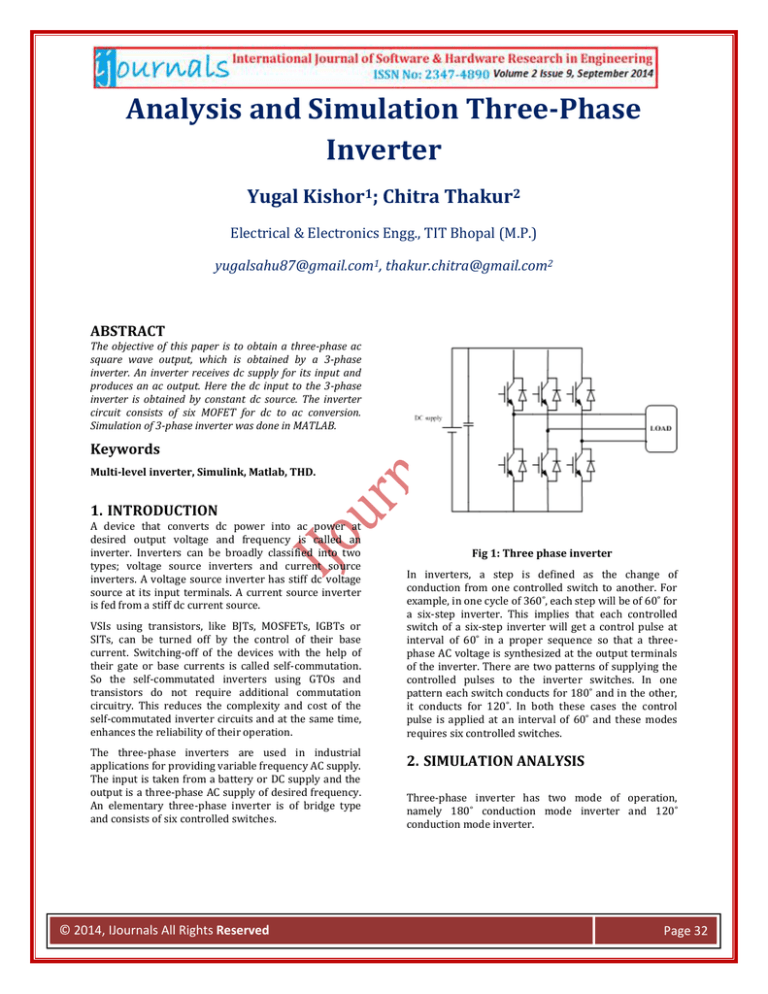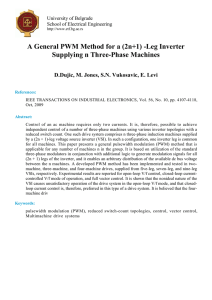
Analysis and Simulation Three-Phase
Inverter
Yugal Kishor1; Chitra Thakur2
Electrical & Electronics Engg., TIT Bhopal (M.P.)
yugalsahu87@gmail.com1, thakur.chitra@gmail.com2
ABSTRACT
The objective of this paper is to obtain a three-phase ac
square wave output, which is obtained by a 3-phase
inverter. An inverter receives dc supply for its input and
produces an ac output. Here the dc input to the 3-phase
inverter is obtained by constant dc source. The inverter
circuit consists of six MOFET for dc to ac conversion.
Simulation of 3-phase inverter was done in MATLAB.
Keywords
Multi-level inverter, Simulink, Matlab, THD.
1. INTRODUCTION
A device that converts dc power into ac power at
desired output voltage and frequency is called an
inverter. Inverters can be broadly classified into two
types; voltage source inverters and current source
inverters. A voltage source inverter has stiff dc voltage
source at its input terminals. A current source inverter
is fed from a stiff dc current source.
VSIs using transistors, like BJTs, MOSFETs, IGBTs or
SITs, can be turned off by the control of their base
current. Switching-off of the devices with the help of
their gate or base currents is called self-commutation.
So the self-commutated inverters using GTOs and
transistors do not require additional commutation
circuitry. This reduces the complexity and cost of the
self-commutated inverter circuits and at the same time,
enhances the reliability of their operation.
The three-phase inverters are used in industrial
applications for providing variable frequency AC supply.
The input is taken from a battery or DC supply and the
output is a three-phase AC supply of desired frequency.
An elementary three-phase inverter is of bridge type
and consists of six controlled switches.
© 2014, IJournals All Rights Reserved
Fig 1: Three phase inverter
In inverters, a step is defined as the change of
conduction from one controlled switch to another. For
example, in one cycle of 360˚, each step will be of 60˚ for
a six-step inverter. This implies that each controlled
switch of a six-step inverter will get a control pulse at
interval of 60˚ in a proper sequence so that a threephase AC voltage is synthesized at the output terminals
of the inverter. There are two patterns of supplying the
controlled pulses to the inverter switches. In one
pattern each switch conducts for 180˚ and in the other,
it conducts for 120˚. In both these cases the control
pulse is applied at an interval of 60˚ and these modes
requires six controlled switches.
2. SIMULATION ANALYSIS
Three-phase inverter has two mode of operation,
namely 180˚ conduction mode inverter and 120˚
conduction mode inverter.
Page 32
2.1 Three-phase 180˚ conduction mode
G1
G3
inverter
G5
g
m
g
m
g
D
S
D
S
D
M3
M1
m
300 ohm
S
Three Phase Load
+
M5
A three-phase 180˚ conduction mode bridge-type
inverter model built up of six MOSFETs, 450V DC
supply, star-connected load of 300Ω, six pulse
generators, and measurement blocks in shown
simulation model in Fig.2. In this inverter, each MOSFET
conducts for 180˚ and hence it is known as three-phase
180˚ voltage source inverter. The MOSFET pair in each
arm, i.e. M1 and M4, M3 and M6, and M5 and M2
conducts for a time interval 180˚. It implies that M1
conducts for 180˚ and then M4 conducts for 180˚, and so
on. Table 6.1 illustrates the switching pattern for 180˚
mode inverter. It can be seen from table-1 that in every
step of 60˚ duration, only three switches are conducting,
i.e. one from the upper group and two from the lower
group or two from the upper group and one from the
lower group.
ON Switches
M1, M5, M6
M1, M2, M6
M1, M2, M3
M2, M3, M4
M3, M4, M5
M4, M5, M6
Display
Mean Value
300 ohm
450 V
DC
+
212.1
RMS
G6
g
D
G4
G2
m
g
S
D
Display1
m
g
S
D
m
RMS
S
3
M2
M6
M4
0.3108
THD
Multimeter
Display2
Total Harmonic
Distorsion
Continuous
powergui
Scope
Fig. 2 Simulation model for three-phase inverter
with 180˚ conduction mode.
The following parameters are measured for the first
phase as can be seen in fig.2:
1.
2.
3.
Table 1: Switching pattern for 180˚ mode threephase VSI.
Angle
0˚-60˚
60˚-120˚
120˚-180˚
180˚-240˚
240˚-300˚
300˚-360˚
-1.377e-07
Mean
300 ohm
+
Vavg = -5.884×10-12V, i.e., almost zero
Vrms=212.1V
THD=0.3108
OFF Switches
M2, M3, M4
M3, M4, M5
M4, M5, M6
M1, M5, M6
M1, M2, M6
M1, M2, M3
The three-phase 180˚ mode VSI model shown in Fig.2 is
simulated from 0 to 0.1 s. the parameters of pulse
generator block G1 are taken as follows: amplitude-5,
period-0.02 s, pulse width-50%, and phase delay-0 s is
taken so that the output voltage waveform is of
frequency 50Hz (1/50 = 0.02). The pulse width of 50%
is taken so that the MOSFET M1 conducts from 0 to 0.01
s, i.e. 0˚ to 180˚. As 0 to 0.02 s is equivalent to 0˚ to 360˚,
the delay of 0.01 s means 180˚ delay in electrical angle.
Similarly, the phase delay for G2 is 0.01s, i.e. 180˚. The
output voltage waveform of the three phases obtained
after simulating the model Fig.4. It can be observed
from Fig.4 that the first phase has phase angle of 60˚,
the second phase -120˚, and third phase 120˚.
Fig. 3 Gate pulses of M4, M6, and M2
Ub: Series RLC Branch
200
0
-200
0
0.01
0.02
0.03
0.04
0.05
0.06
0.07
0.08
0.09
0.1
0.06
0.07
0.08
0.09
0.1
0.06
0.07
0.08
0.09
0.1
Ub: Series RLC Branch1
200
0
-200
0
0.01
0.02
0.03
0.04
0.05
Ub: Series RLC Branch2
Below fig. shows the simulation model for three-phase
inverter.
200
0
-200
0
0.01
0.02
0.03
0.04
0.05
Fig.4 output voltage waveform of three-phases
© 2014, IJournals All Rights Reserved
Page 33
2.2 Three-phase 120˚ conduction mode
inverter
Continuous
The model of a three-phase 120˚ VSI containing a 450V
DC source, six MOSFETs and pulse generators, 300Ω
star-connected load, and measuring blocks is shown in
fig. 5. In case of a 120˚ mode VSI, each switch conducts
for 120˚ of a cycle. Like 180˚ mode, the 120˚ mode
inverter also requires six steps of 60˚ duration for
completing one cycle of output AC voltage waveform. In
this inverter, M1 conducts for 120˚ and for the next
period of 60˚, neither M1 nor M4 conducts. Now, M4 is
turned ON at 180˚ and it conducts for a period of 120˚,
i.e., from 180˚ to 300˚. At 300˚, M4 stops conducting and
60˚ interval elapses before M1 is turned ON again at
360˚. In the bottom row, M3 is turned ON at 120˚ and it
conducts for a period of 120˚ and then it is turned OFF.
At 300˚, M6 is turned ON and it conducts for 120˚. After
the 60˚ interval elapse, M3is turned ON again. The
sequences if firing the six MOSFET switches is same as
that for the 180˚mode inverter. In this case, in each step
only two switches conduct, i.e., one from upper group
and one from the lower group.
Scope
G1
G3
powergui
G5
g
g
g
S
S
D
S
D
Three Phase Load
D
M3
M1
M5
+
450 V
DC
300 ohm
+
300 ohm
+
G6
G4
G2
g
300 ohm
g
S
-6.417e-08
6.044e-08
Display
S
D
D
M2
M6
M4
Mean
Mean Value
g
S
D
6
Multimeter
RMS
183.7
RMS
183.7
Display1
0.3106
THD
Total Harmonic
Distorsion
0.3106
Display2
Fig.5 Simulation model for three-phase inverter
with 120˚ conduction mode.
Table-2: Switching pattern for 120˚ mode threephase VSI
Angle
0˚-60˚
60˚-120˚
120˚-180˚
180˚-240˚
240˚-300˚
300˚-360˚
ON Switches
M1, M6
M1, M2
M2, M3
M3, M4
M4, M5
M5, M6
OFF Switches
M2, M3, M4, M6
M2, M3, M4, M5
M1, M4, M5, M6
M1, M2, M5, M6
M1, M2, M3,M6
M1, M2, M3, M4
The model shown in fig.5 is simulated from 0 to 0.1 s.
The parameters set for pulse generator block G1 are as
follows: Amplitude-5, period-0.02s, pulse width33.34%, and phase delay-0 s. A period of 0.02 s is taken
so as to get a 50Hz waveform at the output and a pulse
width of 33.34% is taken for G1 because M1 conducts
from 0˚ to 120˚, i.e., 0 to 0.0067 s. Similarly, the phase
delay for G2 is 0.01/3 s, for G3 is 0.02/3 s, for G4 is 0.01
s, for G5 is 0.04/3 s, and for G6, it is 0.05/3 s, all other
parameters remaining the same. The delays are set
according to the conduction angle given in table-2 for
each switch. The gate pulses given to switches M1, M3,
and M5 are shown in fig.6. It can be observed that each
switch conducts for 120˚. The output voltage and
current waveforms of the three phases are shown in
fig.7. It can be observed that the first phase has a phase
angle of 0˚, second phase has a phase angle of 120˚, and
the third phase has a phase angle of -120˚.
Fig.6 Gate pulses of M1, M3 and M5
The following parameters are measured for the first
phase as can be seen in fig. 6.
1.
Vavg = -3.342×10-11
2.
Vrms = 183.7V
3.
THD = 0.3106
Ub: Series RLC Branch
Ub: Series RLC Branch1
200
200
0
0
-200
-200
0
0.01
0.02
0.03
0.04
0.05
0.06
0.07
0.08
0.09
0.1
0
0.01
0.02
0.03
Ub: Series RLC Branch2
0.04
0.05
0.06
0.07
0.08
0.09
0.1
0.07
0.08
0.09
0.1
0.07
0.08
0.09
0.1
Ib: Series RLC Branch
1
200
0.5
0
0
-0.5
-200
-1
0
0.01
0.02
0.03
0.04
0.05
0.06
0.07
0.08
0.09
0.1
0
0.01
0.02
0.03
Ib: Series RLC Branch1
0.05
0.06
1
0.5
0.5
0
0
-0.5
-0.5
-1
-1
0
© 2014, IJournals All Rights Reserved
0.04
Ib: Series RLC Branch2
1
0.01
0.02
0.03
0.04
0.05
0.06
0.07
0.08
0.09
0.1
0
0.01
0.02
0.03
0.04
0.05
0.06
Page 34
Fig.7 Output voltage and current waveform of the
three phases.
3. CONCLUSION
The simulation of the inverters namely conventional
three and two level carried out. THD more in two level
inverter, which will be overcome by three level inverter.
The load current for three level inverter are much more
sinusoidal and improvement in the line current
waveform.
4. REFERENCES
[1] Control of high performance DC-AC CONVERTER by
Wei Panda and S.K.Xu.
[2] G.Bhuvaneshwari and Nagaraju “Multilevel inverters
– a comparative study” vol .51 No.2 march – april 2005.
[3] P.K.Chaturvedi, S. Jain, Pramod Agrawal “ Modeling ,
Simulation and Analysis of Three level Neutral Point
CLAMPED inverter using matlab/Simulink/Power
System Blocks.
[4] Bor-Ren Lin & Hsin – Hung Lu “A Novel Multilevel
PWM Control Scheme of the AC/DC/AC converter for AC
Drives”IEEE Trans on ISIE, 1999.
[5] A. M. Massoud, S.J. Finney and B.W. Williams
“Control Techniques for Multilevel Voltage Source
Inverters” IEEE proce. 2003.
[6] M. A. EL- Barky, S.H. Arafah “Simulation and
Implemetaion of Three Phase Three Level Inverter”
SICE july 25- 27, 2001, nagoya.
© 2014, IJournals All Rights Reserved
Page 35






